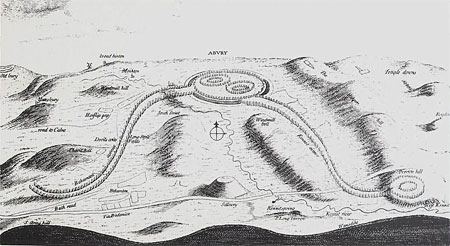
Stukeley’s ‘Avebury Serpent’, showing the disc barrow cut through by the Roman road, and Silbaby as the tail of Waden Hill.

Stukeley’s ‘Avebury Serpent’, showing the disc barrow cut through by the Roman road, and Silbaby as the tail of Waden Hill.

‘It is eternity now. I am in the midst of it. It is about me in the sunshine.‘

Spot the standing stone! Here’s how it looks now, with even more ivy. Note the overhead wires, which seem to get into every picture I take of standing stones on Anglesey...

Whether by accident or design, the passage at Barclodiad-y-Gawres is aligned on these two hills. They don’t look very spectacular, but go there on a clear day and you’ll see that not only does the passage point towards them, but that they stand out against the flat and level horizon.

OK, this isn’t a picture of the Swastika Stone. It’s a picture of a 13th Century gravestone from a church on Anglesey. The swastika (fylfot) design is visible in the centre of the image. The similarity of the design to that of the Swastika Stone makes me think that the latter is also mediaeval in date. (Sorry – the image is a little difficult to make out – it was a bit of a challenge to photograph!).

In the ditch on the eastern side of the hillfort. The interior of the fort and the main bank is on the left, with a smaller counterscarp bank on the right hand side.

The northwest side. Here the footpath runs in the ditch of the hillfort, with the bank visible on the left.